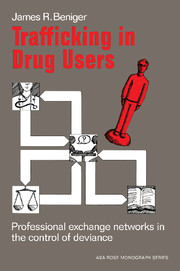Book contents
- Frontmatter
- Contents
- Acknowledgments
- Introduction
- 1 The emergence of the “drug problem”: social change versus social control
- 2 Control systems from exchange in networks: toward a synthesis of system and action theory
- 3 Stratification in information and referral exchange
- 4 Exchange relationships in social-control systems
- 5 The social system: boundary maintenance and hierarchical control
- 6 Summary: the control system in context
- Appendix A The data set
- Appendix B Subgroup sampling and estimated-density spaces (EDS)
- Notes
- Bibliography
- Name index
- Subject index
1 - The emergence of the “drug problem”: social change versus social control
Published online by Cambridge University Press: 07 May 2010
- Frontmatter
- Contents
- Acknowledgments
- Introduction
- 1 The emergence of the “drug problem”: social change versus social control
- 2 Control systems from exchange in networks: toward a synthesis of system and action theory
- 3 Stratification in information and referral exchange
- 4 Exchange relationships in social-control systems
- 5 The social system: boundary maintenance and hierarchical control
- 6 Summary: the control system in context
- Appendix A The data set
- Appendix B Subgroup sampling and estimated-density spaces (EDS)
- Notes
- Bibliography
- Name index
- Subject index
Summary
Midway through the 1960s, the use of psychoactive drugs still drew little notice from the national media and the nation's political leaders. By the end of the decade, illegal drug use and abuse – especially by the young – had not only penetrated the public consciousness, but had become a full-blown national crisis that drew the prolonged attention of both the president and Congress. This emergence in the latter half of the 1960s of a so-called drug problem among the nation's youth remains one of the most rapid and dramatic social changes in U.S. history.
As late as 1964, there were still only 7,000 arrests annually for marijuanalaw violations in the United States, roughly the same number as in previous years. The Readers’ Guide to Periodical Literature that year indexed scarcely a dozen articles under the headings “marijuana,” “LSD,” and “heroin” combined. The first Gallup survey of drug use on American college campuses was still three years away.
By 1966, the number of marijuana arrests had doubled to 15,000. Surveys by campus newspapers at Yale, Princeton, and Caltech put the number of undergraduates who had at least experimented with marijuana at about 25 percent. The commissioner of the Food and Drug Administration, in a letter to officials at more than 2,000 colleges and universities, urged “concerted action” against the illegal use of drugs by college students.
The following summer, Newsweek ran a cover story under the headline, “Marijuana – The Pot Problem.” “By all reports,” the magazine stated, “marijuana has come downtown from the ghetto and the fringes of the middle class and entered the mainstream of U.S. life.”
- Type
- Chapter
- Information
- Trafficking in Drug UsersProfessional Exchange Networks in the Control of Deviance, pp. 7 - 30Publisher: Cambridge University PressPrint publication year: 1984



